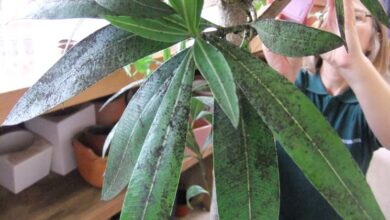7 cold water aquarium plants

If you have or are going to have a cold water aquarium, you will be interested in decorating it with some plants that are capable of living well in those conditions, right? And it is that having one is quite an experience, capable of relaxing just by observing what happens in it. In addition, it looks great in any corner of the home.
But if you have doubts about which species are the most suitable, you can spend too much time searching. So don’t worry: we show you the best cold water aquarium plants.
Selection of cold water aquarium plants
Looking for plants for your cold water aquarium? If you want to be able to enjoy your aquarium to the fullest, decorate it with some of the plant/ s that we recommend:
Anubias barteri

Image – Wikimedia/ Carlosar
The Anubias barteri is a herbaceous plant known as broadleaf Anubia originating in West Africa. The leaves are almost leathery, simple and relatively long, up to 30 centimeters. The flowers are grouped in pedunculated inflorescences, greenish or yellowish in color.
It can be put in the place of the aquarium where it is preferred, but it is ideal, taking into account its size, to put it at the back or, at least, in the middle.
You can buy it here.
Cardamine lyrata

Image – Wikimedia/ batra3x
The Cardamine lyrata, known as water cress, ivy Cardamine of China or Japan, is a herbaceous plant native to eastern China, eastern Siberia, Korea and Japan. It reaches a height of 20 to 40 centimeters and up to 30 centimeters wide. The leaves are round with serrated margins, and are highly palatable to fish.
It is a beautiful plant with which to have beautiful natural ‘mattresses’ in the aquarium. Of course, due to its height it is advisable to place it on the sides or in the central part.
Echinodorus ‘Barthii’

Image – floridaaquatic.com
The Echinodorus ‘barthii’ is an herbaceous plant of South America which reaches a height of between 25 and 50 centimeters, and that develops a leaf rosette 20 to 30 centimeters wide. These leaves are very peculiar: when young they are dark red, but as they reach their final size they turn dark green.
It grows fast, which is why it must be pruned occasionally in order to prevent it from invading the space of other aquatic plants.
You can buy it here.
Eleocharis acicularis

Image – Flickr/ Maico Weites
The Eleocharis acicularis, known as a spikelet, jonquil or cirpus like needle, is a perennial rhizomatous plant native to Eurasia, America and Africa. It develops straight or slightly arched stems up to 22 centimeters, green in color. Its flowers are grouped in spikelets of up to 6mm, and the fruit is a 1.5 x 0.5mm achene.
It is recommended to put in the rear or middle part, as it forms quite dense upholstered areas.
Gymnocoronis spilanthoides

Image – Wikimedia/ John Tann from Sydney, Australia
The Gymnocoronis spilanthoides is a herbaceous perennial plant native to South America that develops elliptical, simple, green and marked midrib leaves white-green color. It grows between 8 and 12 inches tall.
Place in the rear or middle part, since its growth rate is fast. This is a characteristic that makes it a very interesting kind of aquarium, since it can prevent the appearance of algae.
Hottonia inflata

The Hottonia inflata is an herbaceous plant native to the eastern United States and the Gulf of Mexico. It reaches a height of 30 centimeters, and develops alternate leaves, with a pinnate or bipinnate division, of green color. The flowers are small, white or purple, and appear at the end of the flower stalks.
It has to be put at the back of the aquarium, so that it can receive all the light it needs without causing problems for the rest of the plants.
Microsorum pteropus

Image – Wikimedia/ Pinpin
The Microsorum pteropus, known as Java fern is a herbaceous plant that reaches a height of up to 35 centimeters. The blades can be thin, needle, spear, trident or Windelov shaped.
It has a rapid growth rate but not excessively, so it is usually placed at the back of the aquarium.
You can buy it here.
What care do cold water aquarium plants need?
For everything to go well from the beginning, it is necessary to know a little about the needs of aquarium plants. So, you should keep the following in mind:
- Temperature: the plants that we have shown you live well in waters whose temperature remains between 15 and 30ºC.
- Substrate: preferably quartzite, with small grains of between 1 and 2mm so that the fish have more difficulty digging them up.
- Lighting: it will depend on the species. Those of the genus Anubias for example live well with the natural light of the house, but there are others such as those of the genus Lilaeopsis that will require extra lighting.
- Filtration: the installation of relatively large filters is important, since having plants and if fish are also going to be introduced will cause the water to become cloudy quickly.
- Subscriber: specific fertilizers for aquarium plants must be used throughout the year. Also, if you are going to have fish, you must inform yourself well before these products are not toxic to them.

Image – Wikimedia/ Matthias Kloszczyk
I hope it has been useful to you .




